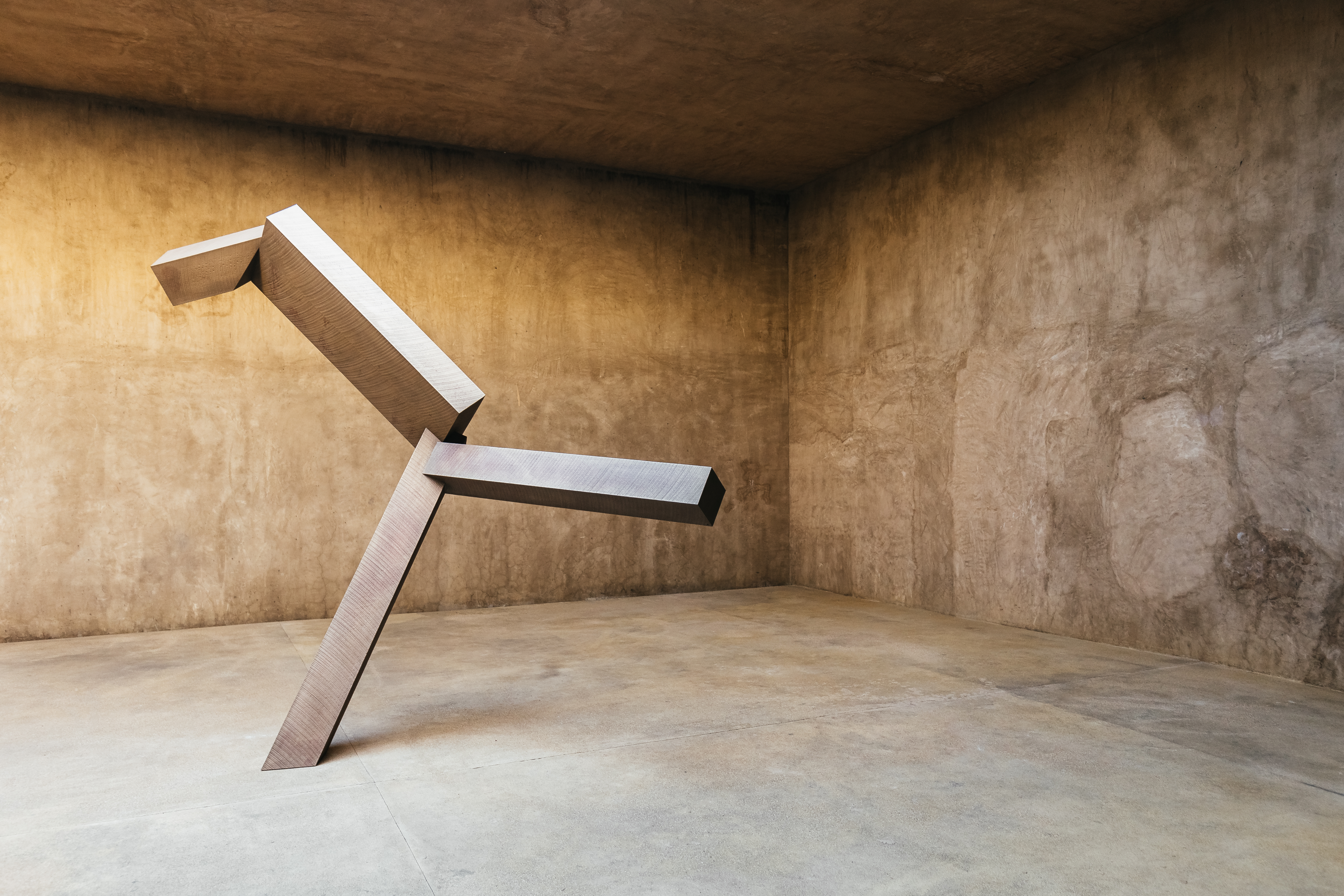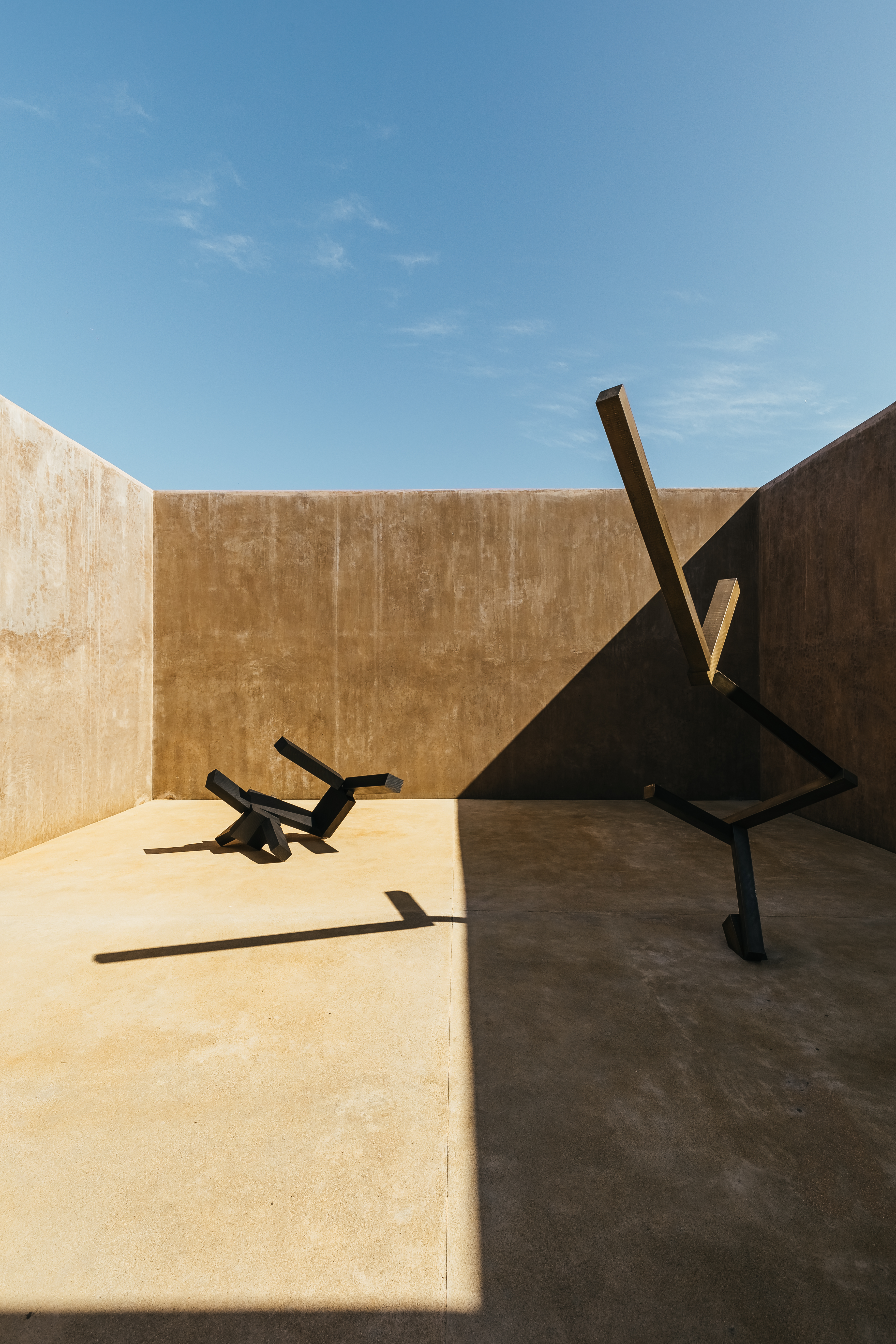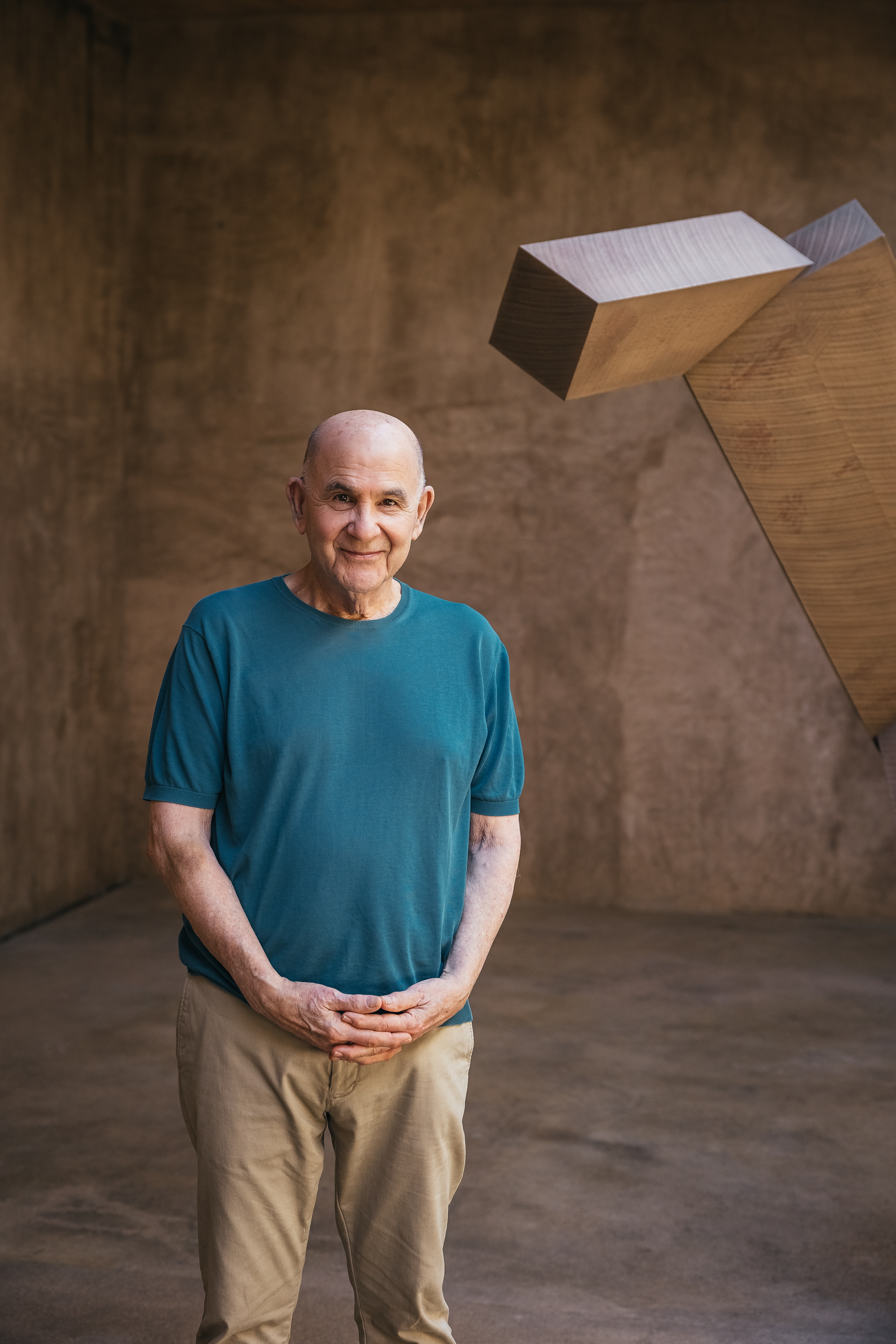JOEL SHAPIRO: FOUR BRONZES
FEBRUARY 2 – JULY 9, 2024
Meridiano is pleased to announce Joel Shapiro: Four Bronzes, the first solo exhibition of the artist in Mexico, opening Friday, February 2, 2024. Presenting four large-scale works spanning twenty-five years of the artist’s career, the exhibition foregrounds Shapiro’s radical refinements to the core elements of sculpture: gravity, structure, and movement. Across the installation, Shapiro dynamically engages with the immersive architecture of the gallery, a site along the Oaxacan coast whose structure is echoed within the artist’s consideration of the expressive capabilities of essential forms, lines, and colors.
Renowned for developing a distinctive formal language in the 1980s and ’90s that confronted the dominant severity of minimalism, the artist’s simplified geometric compositions fluidly move between figuration and abstraction. Blurring the boundary between the formal and the personal, Shapiro’s sculptures relate to this history of reduction while favoring the dynamic possibilities of gesture intrinsic to the artist’s work since the early 1970s. In dialogue with one another for the first time, the freestanding sculptures alongside one wall-mounted work explore the spatial implications of balance and weight. Each of the bronze sculptures, whose rich surfaces range from pale copper and gunmetal patinas to brightly painted blue, retain the milled grain texture of the original wood forms Shapiro uses to create his castings.
Renowned for developing a distinctive formal language in the 1980s and ’90s that confronted the dominant severity of minimalism, the artist’s simplified geometric compositions fluidly move between figuration and abstraction. Blurring the boundary between the formal and the personal, Shapiro’s sculptures relate to this history of reduction while favoring the dynamic possibilities of gesture intrinsic to the artist’s work since the early 1970s. In dialogue with one another for the first time, the freestanding sculptures alongside one wall-mounted work explore the spatial implications of balance and weight. Each of the bronze sculptures, whose rich surfaces range from pale copper and gunmetal patinas to brightly painted blue, retain the milled grain texture of the original wood forms Shapiro uses to create his castings.


Through experimentation with volume, space, and scale, the installation activates both the enclosed structure and surrounding outdoor space of Meridiano through a series of rectilinear, anthropomorphic bronzes. Shapiro’s introduction of bronze to Meridiano’s atmosphere, a structure realized primarily in stone and natural lime plaster, creates an elemental complement that embraces the site’s materiality. Under the open-air conditions of the space, an example of time-based architecture whose only light source consists of an oculus open to the sun and stars, Shapiro’s works are exposed to the environment.
Conceived by Tatsuro Miki and Axel Vervoordt, the architectural design of Meridiano draws from the tenets of sacred geometry, oriented in line with Teotihuacán to the four cardinal directions: the Pacific Ocean to the south, the mountain range to the north, and the border between land and sea striking straight from due east to due west. The dynamism of Shapiro’s sculptures is mirrored in the viewing experience, where the passage of time visible through the isolated fragment of sky within the gallery and its surrounding landscape presents a shifting setting. Depending on the hour of the day, the geometry of shadows cast by the artist’s bronzes traces different forms.
The implied movement imbued in Shapiro’s figurative allusions is also significant in the context of the cultural history of the and it occupies. In the graphic conventions of Mesoamerican codices, manuscripts once used to describe the cosmos by indigenous civilizations, expressed mythic narratives in spatial, even choreographic form. The shape of the maps was determined by the limits of the page, each a panel of space, whose borders were decorated by signs that indicated direction. The basis of this cartography was often informed by celestial observation—of how the moon, stars, and planets moved across the sky. Likewise, how viewers navigate Shapiro’s work is determined by the relationship one object holds with the next, an internal consistency shared with readings of the cosmological codex. In Joel Shapiro: Four Bronzes, how space and scale perform is as much about the suggestion of the body inherent within the sculptures as it is about how our bodies move around them.
Shapiro’s sculptures map figures as planar beings, where points transform into lines, and lines into volumes, often appearing like bodies captured in motion. “While minimalism is against reference, I’ve always insisted on being referential,”1 says Shapiro. The accuracy of scale, measurement, and orientation in cosmological architecture was supplanted by personal perception: their sightlines were not universal, but rather local and contingent on the specific latitude of the site’s geography. Shapiro’s work assumes a similar relationship to place within Meridiano.
![]()



Gestalt psychology tells us that people perceive collections of objects, shapes, and forms as whole rather than separate entities. This effect exists not only in Shapiro’s individual sculptures but also in their proximity to one another. The characteristic poses of Shapiro’s sculptures are animated by placement. For example, how one appears to reach upward, treelike in its extension, as the other falls, limbs suspended as they shatter into the ground. Each appears ready to be identified as either figures, as a collection of bodies communing with one another, or a sum of its parts, as planes dissolving into a field of harmonious cubic abstractions. His sculptures remain on the verge, never claiming to belong to just one category, but dynamically lingering in the balance of both to question how we see geometry in connection to the world and ourselves.
ABOUT THE ARTIST
Joel Shapiro (b. 1941, New York City / lives and works New York City) has explored the possibilities of sculptural form throughout his over-fifty-year career in the arts. Since his first solo exhibition in 1970, his work has been the subject of numerous solo and retrospective exhibitions worldwide, at institutions including the Whitechapel Gallery, London, 1980; Whitney Museum of American Art, New York, 1982; Stedelijk Museum, Amsterdam, 1985; Walker Art Center, Minneapolis (jointly with The Nelson-Atkins Museum, Kansas City), 1995–96; Iris and B. Gerald Cantor Roof Garden, The Metropolitan Museum of Art, New York, 2001; Museum Ludwig, Cologne, 2011; Nasher Sculpture Center, Dallas, 2016; Kunstmuseum Winterthur, Switzerland, 2017; Yale University Art Gallery, 2018; and The Madison Museum of Contemporary Art, 2018. His work can be found in numerous public collections in the United States and abroad, including The Museum of Modern Art, Whitney Museum of American Art, and The Metropolitan Museum of Art in New York; Museum of Fine Arts, Boston; Hirshhorn Museum and Sculpture Garden, Smithsonian Institution, and the National Gallery of Art in Washington, D.C.; Philadelphia Museum of Art; The Art Institute of Chicago; The Menil Collection and the Museum of Fine Arts, Houston; Nasher Sculpture Center, Dallas; Los Angeles County Museum of Art, The J. Paul Getty Museum, and The Museum of Contemporary Art in Los Angeles; the Tate Gallery, London; IVAM Centre Julio González, Valencia; Serralves Foundation Museum of Contemporary Art, Portugal; Stedelijk Museum, Amsterdam; Skulpturenpark Köln, Cologne; Moderna Museet, Stockholm; and Musée National d’Art Moderne, Centre Georges Pompidou, Paris.
Joel Shapiro (b. 1941, New York City / lives and works New York City) has explored the possibilities of sculptural form throughout his over-fifty-year career in the arts. Since his first solo exhibition in 1970, his work has been the subject of numerous solo and retrospective exhibitions worldwide, at institutions including the Whitechapel Gallery, London, 1980; Whitney Museum of American Art, New York, 1982; Stedelijk Museum, Amsterdam, 1985; Walker Art Center, Minneapolis (jointly with The Nelson-Atkins Museum, Kansas City), 1995–96; Iris and B. Gerald Cantor Roof Garden, The Metropolitan Museum of Art, New York, 2001; Museum Ludwig, Cologne, 2011; Nasher Sculpture Center, Dallas, 2016; Kunstmuseum Winterthur, Switzerland, 2017; Yale University Art Gallery, 2018; and The Madison Museum of Contemporary Art, 2018. His work can be found in numerous public collections in the United States and abroad, including The Museum of Modern Art, Whitney Museum of American Art, and The Metropolitan Museum of Art in New York; Museum of Fine Arts, Boston; Hirshhorn Museum and Sculpture Garden, Smithsonian Institution, and the National Gallery of Art in Washington, D.C.; Philadelphia Museum of Art; The Art Institute of Chicago; The Menil Collection and the Museum of Fine Arts, Houston; Nasher Sculpture Center, Dallas; Los Angeles County Museum of Art, The J. Paul Getty Museum, and The Museum of Contemporary Art in Los Angeles; the Tate Gallery, London; IVAM Centre Julio González, Valencia; Serralves Foundation Museum of Contemporary Art, Portugal; Stedelijk Museum, Amsterdam; Skulpturenpark Köln, Cologne; Moderna Museet, Stockholm; and Musée National d’Art Moderne, Centre Georges Pompidou, Paris.



